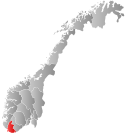Feda is a former municipality in the old Vest-Agder county, Norway. The 66-square-kilometre (25 sq mi) municipality existed from 1900 until its dissolution in 1963. The administrative centre was the village of Feda where the Feda Church is located. Feda encompassed the far southern tip of the present-day municipality of Kvinesdal in what is now Agder county. It surrounded both sides of the 13-kilometre (8.1 mi) long Fedafjorden and the surrounding valleys.[2]
Feda Municipality
Feda herred | |
|---|---|
| Fede (historic name) | |
 View of the mouth of the Fedaelva river and the Fedafjorden | |
 Vest-Agder within Norway | |
 Feda within Vest-Agder | |
| Coordinates: 58°16′00″N 06°49′11″E / 58.26667°N 6.81972°E | |
| Country | Norway |
| County | Vest-Agder |
| District | Lister |
| Established | 1 Jan 1900 |
| • Preceded by | Kvinesdal Municipality |
| Disestablished | 1 Jan 1963 |
| • Succeeded by | Kvinesdal Municipality |
| Administrative centre | Feda, Norway |
| Area (upon dissolution) | |
• Total | 66 km2 (25 sq mi) |
| Population (1963) | |
• Total | 576 |
| • Density | 8.7/km2 (23/sq mi) |
| Time zone | UTC+01:00 (CET) |
| • Summer (DST) | UTC+02:00 (CEST) |
| ISO 3166 code | NO-1038[1] |
History
editThe municipality of Feda was created on 1 January 1900 when the old municipality of Kvinesdal was split into two separate municipalities: Feda (population: 1,090) and Liknes (population: 2,937). During the 1960s, there were many municipal mergers across Norway due to the work of the Schei Committee. On 1 January 1963, Feda municipality was dissolved and it was merged with Kvinesdal municipality (in 1917 Liknes was renamed Kvinesdal) and Fjotland to create a new, larger municipality of Kvinesdal. Prior to the merger, Feda had 576 inhabitants.[3]
Name
editThe municipality (originally the parish) is named after the old Fede farm (Old Norse: Feta). The farm was named after the local river, now known as the Fedaelva (which flows into the Fedafjorden near the farm). The meaning of the name comes from the Old Norse word fit which means "lush meadow on the banks of a river".[4] Historically, the name of the municipality was spelled Fede. On 3 November 1917, a royal resolution changed the spelling of the name of the municipality to Feda.[5]
Government
editWhile it existed, this municipality was responsible for primary education (through 10th grade), outpatient health services, senior citizen services, unemployment, social services, zoning, economic development, and municipal roads. During its existence, this municipality was governed by a municipal council of directly elected representatives. The mayor was indirectly elected by a vote of the municipal council.[6]
Municipal council
editThe municipal council (Herredsstyre) of Feda was made up of representatives that were elected to four year terms. The tables below show the historical composition of the council by political party.
| Party name (in Norwegian) | Number of representatives | |
|---|---|---|
| Local List(s) (Lokale lister) | 13 | |
| Total number of members: | 13 | |
| Party name (in Norwegian) | Number of representatives | |
|---|---|---|
| Labour Party (Arbeiderpartiet) | 2 | |
| Local List(s) (Lokale lister) | 11 | |
| Total number of members: | 13 | |
| Party name (in Norwegian) | Number of representatives | |
|---|---|---|
| Labour Party (Arbeiderpartiet) | 2 | |
| Local List(s) (Lokale lister) | 10 | |
| Total number of members: | 12 | |
| Party name (in Norwegian) | Number of representatives | |
|---|---|---|
| Labour Party (Arbeiderpartiet) | 1 | |
| Local List(s) (Lokale lister) | 11 | |
| Total number of members: | 12 | |
| Party name (in Norwegian) | Number of representatives | |
|---|---|---|
| Local List(s) (Lokale lister) | 12 | |
| Total number of members: | 12 | |
| Party name (in Norwegian) | Number of representatives | |
|---|---|---|
| Labour Party (Arbeiderpartiet) | 2 | |
| Joint List(s) of Non-Socialist Parties (Borgerlige Felleslister) | 10 | |
| Total number of members: | 12 | |
| Note: Due to the German occupation of Norway during World War II, no elections were held for new municipal councils until after the war ended in 1945. | ||
See also
editReferences
edit- ^ Bolstad, Erik; Thorsnæs, Geir, eds. (26 January 2023). "Kommunenummer". Store norske leksikon (in Norwegian). Kunnskapsforlaget.
- ^ Store norske leksikon. "Feda – tidligere kommune" (in Norwegian). Retrieved 14 September 2016.
- ^ Jukvam, Dag (1999). Historisk oversikt over endringer i kommune- og fylkesinndelingen (PDF) (in Norwegian). Statistisk sentralbyrå. ISBN 9788253746845.
- ^ Rygh, Oluf (1912). Norske gaardnavne: Lister og Mandals amt (in Norwegian) (9 ed.). Kristiania, Norge: W. C. Fabritius & sønners bogtrikkeri. p. 279.
- ^ "Norsk Lovtidende. 2den Afdeling. 1917. Samling af Love, Resolutioner m.m". Norsk Lovtidend (in Norwegian). Kristiania, Norge: Grøndahl og Søns Boktrykkeri: 1057–1065. 1917.
- ^ Hansen, Tore; Vabo, Signy Irene, eds. (20 September 2022). "kommunestyre". Store norske leksikon (in Norwegian). Kunnskapsforlaget. Retrieved 1 January 2023.
- ^ "Kommunevalgene og Ordførervalgene 1959" (PDF) (in Norwegian). Oslo: Statistisk sentralbyrå. 1960. Retrieved 19 November 2020.
- ^ "Kommunevalgene og Ordførervalgene 1955" (PDF) (in Norwegian). Oslo: Statistisk sentralbyrå. 1957. Retrieved 19 November 2020.
- ^ "Kommunevalgene og Ordførervalgene 1951" (PDF) (in Norwegian). Oslo: Statistisk sentralbyrå. 1952. Retrieved 19 November 2020.
- ^ "Kommunevalgene og Ordførervalgene 1947" (PDF) (in Norwegian). Oslo: Statistisk sentralbyrå. 1948. Retrieved 19 November 2020.
- ^ "Kommunevalgene og Ordførervalgene 1945" (PDF) (in Norwegian). Oslo: Statistisk sentralbyrå. 1947. Retrieved 19 November 2020.
- ^ "Kommunevalgene og Ordførervalgene 1937" (PDF) (in Norwegian). Oslo: Statistisk sentralbyrå. 1938. Retrieved 19 November 2020.